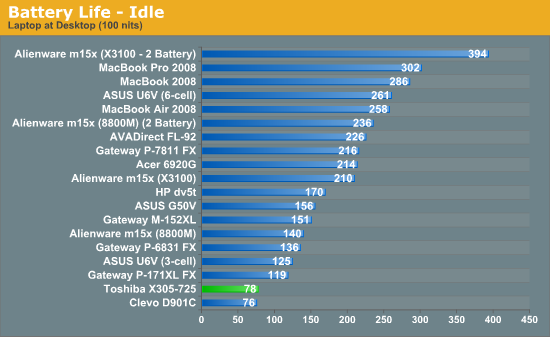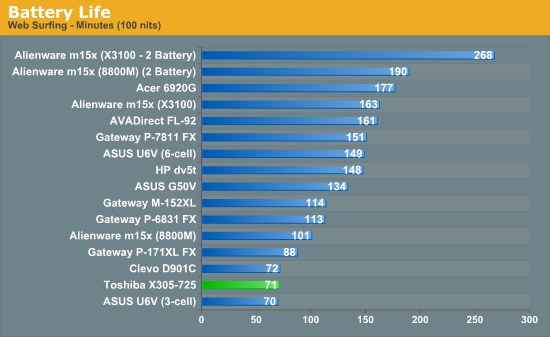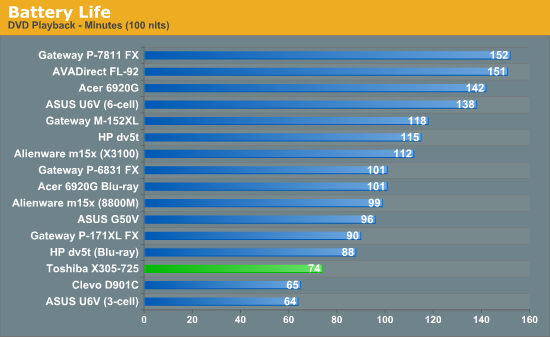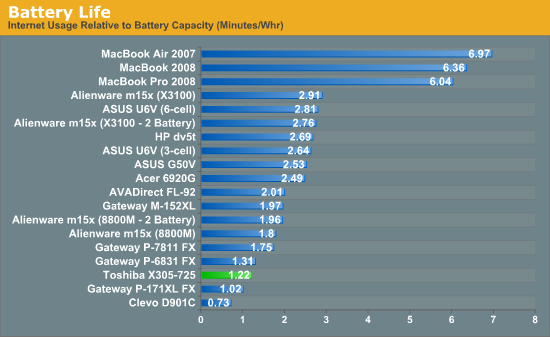Toshiba X305-Q725: Quad-Core Gaming Notebook
by Jarred Walton on March 11, 2009 1:00 AM EST- Posted in
- Laptops
Battery Life
We hope you already understand going into this review that the X305-Q725 is going to have rater dismal battery life. To say that battery life isn't a major focus is a gross understatement. This is evidenced by the battery itself, which is a 6-cell 58Whr unit. The single GPU means that the X305 consumes less power than most SLI notebooks, but with the smaller battery we still end up at just over one hour of mobile usage before you need to plug in.
For battery life testing, we run all laptops at around 100 nits brightness. If you choose to run your LCD at maximum brightness, you may lose anywhere from 10 to 60 minutes depending on the laptop - the latter is mostly for ultra-mobile options while the former is for gaming notebooks. In this instance, we were unable to set the X305 to 100 nits; maximum brightness was 180 nits, but one notch down results in a drop to just 80 nits. We'd really like to see more fine-grained adjustment here, as cutting the brightness in half is far too big a drop for one "step". However, even at the reduced brightness the battery life is poor (and we only lost about 5 minutes by setting brightness to 100%).
We run four different battery life scenarios: Internet surfing (load several webpages using the wireless adapter every minute until the battery dies), DVD playback, x264 playback, and idle (maximum) battery life. For x264 playback, we copy a 720p file to the hard drive and loop playback using Windows Media Player Classic. We will also include battery life results for Blu-ray playback in the DVD chart where appropriate. We've also included web surfing results (and DVD for the MBP) for the latest Apple MacBooks as a point of reference.




There are a few things that are noteworthy, the first being the very short battery life. What's more surprising, however, is that there doesn't seem to be any reasonable way of increasing battery life. Even our idle battery life test is barely any better than the x264 playback life, suggesting that the laptop never really enters low-power CPU states. The Clevo D901C behaves in a similar fashion, so it appears many DTR systems spend very little effort in improving mobility.
As we've mentioned in the past, Apple's MacBook and MacBook Pro provide an almost untouchable amount of battery life. To give you a true apples-to-Apples comparison, we've calculated the amount of battery life you get per Whr (Watt Hour) of battery capacity:

The X305-Q725 actually does better than a couple notebooks in life per Whr, beating the D901C by 67%. The combination of a 45nm CPU with DDR3 memory results in only moderately high power requirements. Obviously, the desktop CPU and second GPU in the D901C really kick the power usage up a notch. It's also interesting that the Gateway FX P-6831 only does marginally better. The older 65nm process and other design decisions make Gateway's original FX line rather inefficient, though the later P-7811 improves things quite a bit.










32 Comments
View All Comments
Dfere - Thursday, March 12, 2009 - link
A business power user needs some mobility. I use a laptop as my main business computer. It would be nice to have something to play games at an ok rate. But given the bugs, let alone the power issues, I wouldn't. I need some mobility and I need my data and system operational to make revenue.A plain gamer/laptop lover wouldn't because it isn't a top performer, and thats why they buy.
JimmiG - Thursday, March 12, 2009 - link
I used to travel a lot between point A and point B and wanted a good gaming system at both places. I was considering a gaming laptop for a while but ended up building myself a Shuttle SFF system instead. Fit perfectly in the backpack together with my other belongings, cost about 1/4th of a gaming laptop and offered 95% of the performance of a full tower system. I just used a cheap 19" CRT monitor at one place and the LCD at the other. Amazing how small and light that system was.Of course if you travel a lot between many different location, this kind of laptop might make sense. Just hook it up when you arrive at the hotel room, cabin etc., and you've got a full gaming setup. Of course, if you don't care about games, you'd be better served by a netbook or 13" laptop...
Enoc - Wednesday, March 11, 2009 - link
with the AMD/Ati 4850 and 4870 for mobile... why these companies still use the renamed 9400/9500/9600/9800gt/gtx...? and what it worse some people think the GTX 280M is the same as the deskstop counterpart but is really a 9800GTX...
AMD has a good oportunity if more OEM embrace the 4850/4870 for the enthusiast notebook segment like MSI has done and if they introduce low power(HE) quads and triple cores for this segment that would be a nice move...
with $1500+- you could build something better with a compal/saeger barebone...
JarredWalton - Thursday, March 12, 2009 - link
Sager doesn't make barebones, I don't think; they use Clevo offerings. But yes, you can put together a better custom system I think. Pricing might not be much better, though.Memph - Wednesday, March 11, 2009 - link
I'v had similar expiriences with my qosmio. The problems in the old drivers. have to uninstall them (twice) from the safe mode. and then install the newest nvidia drivers. Mine used to lock up randomly. Now everything works perfectly.jabber - Wednesday, March 11, 2009 - link
I've had several laptops over the years. Best fix I've found for stability is to blitz the manufacturers build asap and slap on a fresh build with the latest OS. Go to the manufacturers site for drivers that you cant find elsewhere as they will generally be two or three versions on from the ones the laptop came with.There will also be a new BIOS update usually.
Has always got rid of the quirks for me.
JarredWalton - Wednesday, March 11, 2009 - link
FWIW, the instability issue always cropped up with a graphics application - game - running. (Well, there was the SysInfo issue with 3D/PCMark Vantage, but that's clearly a driver problem that they addressed.) I did run Folding@Home SMP on the laptop non-stop for several days with no crashes caused there. I did not test the GPU folding client, though, which would have been interesting to check now that I think about it.Personally, I do not run Folding@Home on laptops (anymore); it just places a huge load on the system and is almost asking your laptop to die a premature death. For that matter, I've stopped running it on most of my desktops as well - power costs for all the running computers were too much, so it's much cheaper to just leave them off when they're not in use.
Wolfpup - Wednesday, March 11, 2009 - link
Be funny to people? My notebook is my main system...I mean why not?Anyway, I'm so glad Anandtech is continuing to cover power laptops!
I hate how gaudy this is, but I'd certainly consider it if not for the lack of Blu Ray and LED backlight. I actually prefer the single high end GPU route...
Plus obviously the instability is disturbing. Must be a hardware defect somewhere, or else a bad driver. I've been Folding non stop on the CPU and GPU of my (much lower end) Asus n80 with a Penryn/Geforce 9650GT and it hasn't crashed once.
piroroadkill - Wednesday, March 11, 2009 - link
17" is too large for a notebook in my opinion, even a gaming one. 15.4" widescreen @ 1680x1050 would be perfect. Also how did they manage to make this thing so goddamn thick?!Blahman - Friday, March 13, 2009 - link
Check this one out, matches your requirements exactly: http://www.msimobile.com/level3_productpage.aspx?c...">http://www.msimobile.com/level3_productpage.aspx?c...